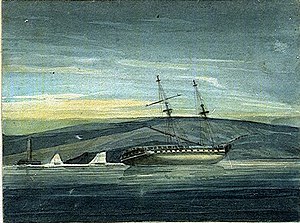HMS Shannon (1803)
 Shannon on shore, by Edward Pelham Brenton, c.1803, in the National Maritime Museum, Greenwich
| |
| History | |
|---|---|
| Name | HMS Shannon |
| Ordered | 8 July 1801 |
| Builder | Josiah and Thomas Brindley, Frindsbury, Kent |
| Laid down | August 1801 |
| Launched | 2 September 1803 |
| Fate | Wrecked 10 December 1803 |
| General characteristics [1] | |
| Type | 36-gun fifth-rate frigate |
| Tons burthen | 88128⁄98 bm |
| Length |
|
| Beam | 38 ft 2+3⁄4 in (11.7 m) |
| Depth of hold | 13 ft 5+1⁄4 in (4.1 m) |
| Propulsion | Sails |
| Complement | 264 |
| Armament |
|
The third HMS Shannon was a 36-gun frigate of the British Royal Navy built at Frindsbury on the River Medway on the Thames Estuary. She was completed on 3 September 1803 during the Napoleonic Wars. Her name was changed from Pallas to Shannon shortly before construction, traditionally an omen of bad luck for a ship. In her case, she was wrecked within three months of her being launched.
Wreck
She was attached to the Channel fleet and spent the next few months under her captain, Edward Leveson-Gower, on patrol off the Cape La Hogue searching for French coastal shipping and privateers attempting to slip out of the Normandy port of Cherbourg. The 18-gun brig HMS Merlin, under Edward Pelham Brenton, accompanied her.
At 8pm on 10 December, just three months after she was completed, the ship was lost on Tatihou Island, near Barfleur, directly under an enemy battery. There was a heavy gale blowing and in the darkness, Leveson-Gower lost his position after losing sight of the Barfleur lighthouse. Assuming he had sea room, he attempted to wear around; a lee tide caught Shannon and crashed her straight onto the rocks.[2] Merlin spotted land thanks to a bolt of lighting and was able to wear off in time.
Efforts overnight to lighten Shannon succeeded in that eventually she floated, but she was so full of water that she grounded again and it was evident that she was lost. During these efforts, a French battery fired on Shannon, striking her with some 60 shots and killing three men wounding eight.[1] At 8:30p.m. Shannon struck.[2] The surviving crew were able to scramble ashore unharmed, where the French troops garrisoning the battery above the wreck captured them. Some French fishing boats led by Ensign Lacroix took possession of Shannon, and saw that her hull was so damaged that she would be impossible to refloat.[3]
Merlin stood back into shore on the 16th and at 11.30am dispatched two boats of marines and sailors to destroy Shannon to prevent the French from salvaging her guns and stores. Despite heavy fire from the island's batteries the boarders were able to burn and destroy the frigate without suffering a single casualty.[Note 1]
Aftermath
Edward Pelham Brenton was the younger brother of Captain Jahleel Brenton, who was a captive at Verdun, where Leveson-Gower would join him in January 1804. About three and a quarter years after the loss of Shannon, Leveson-Gower and his officers returned to England. There a court martial honorably acquitted them of all blame for the loss.
Notes, citations, and references
Notes
Citations
- ^ a b Winfield (2008), p. 158.
- ^ a b Hepper (1994), p. 103.
- ^ a b Troude (1867), p. 306.
References
- Colledge, J. J.; Warlow, Ben (2006) [1969]. Ships of the Royal Navy: The Complete Record of all Fighting Ships of the Royal Navy (Rev. ed.). London: Chatham Publishing. ISBN 978-1-86176-281-8.
- Hepper, David J. (1994). British Warship Losses in the Age of Sail, 1650-1859. Rotherfield: Jean Boudriot. ISBN 0-948864-30-3.
- James W.M., The Naval History of Great Britain, Vol. 3, Conway, Great Britain: 2002 (originally published 1827). ISBN 0-85177-907-7.
- King, Ian M. (2012). "HMS Shannon (1803)". britainsnavy.co.uk. Retrieved 8 February 2012.
- Troude, Onésime-Joachim (1867). Batailles navales de la France (in French). Vol. 3. Challamel ainé.
- Winfield, Rif (2008). British Warships in the Age of Sail 1793–1817: Design, Construction, Careers and Fates. Seaforth Publishing. ISBN 1-86176-246-1.
